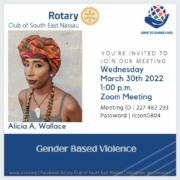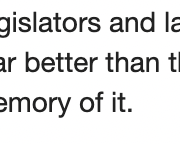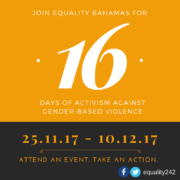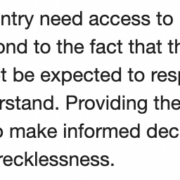On the weekend, it was reported that a four-year-old child was taken to the hospital. Soon after, there were claims on social media that the toddler had been sexually assaulted. The toddler, Bella Walker, died.
This assault, not yet confirmed by the Royal Bahamas Police Force which claims it is still waiting for autopsy results, has been met with outrage. People are angry about this child allegedly being abused, and the suggestion that the abuse caused her death. In this state of anger – one that comes and goes as the general public hears a horrific story and, given enough time, forgets about it – people are calling for action.
Anger can be a strong motivator and lead to things getting done, but those are not usually the right things. It is important for us to recognize this as a pivotal moment.
Nothing we do will bring Bella back or undo the abuse she went through or the suffering of the people who loved her.
While we honour her, mourn the loss and empathize with the people who loved her, we have to look at our circumstances. We have to see the gap between where we are and where we need to be, then figure out what we need to do to move from here to there. We will not get there by doing the first thing that comes to mind when we are enraged and want vengeance. If we are to address the scourge that is sexual violence, beyond individual incidents, we have to identify the issue and the systems that allow it to persist.
Gender-based violence refers to harmful acts directed at an individual based on their gender or that affects people of a particular gender disproportionately. Examples include sexual harassment, female genital mutilation, forced marriages, stalking and sexual violence. Gender-based violence occurs in both public and private spaces, and it can be perpetrated by individuals, organizations and states.
Sexual violence includes non-consensual vaginal, anal, or oral penetration, non-consensual capture or distribution of photos or videos and sex trafficking. Globally, 35 percent of women have experienced physical or sexual violence and 38 percent of murders of women are committed by intimate partners.
Intimate partner violence is a pattern of behaviour used by one partner to maintain control over the other, and it is disproportionately experienced by women. Domestic violence is an incident or pattern of incidents of controlling, coercive, threatening, degrading and violent behaviour between people in the same household including spouses, people who are dating, parents, children and cohabitants.
Child abuse is the harm of anyone under 18, including one-time events and a series of events over a period of time. This includes physical abuse, psychological abuse, sexual abuse and neglect. Perpetrators of child abuse may include family members, friends, people in positions of authority over them, people in community settings and strangers.
Children are often afraid of telling anyone that they are being abused, but there are often signs of abuse. These include being afraid to be around certain people or in certain places, being unusually withdrawn, running away, not being taken to the doctor, and knowing things that are not suitable for their age. They depend on adults to see the signs and take action to protect them.
Neighbours told reporters that Bella’s mother was in an abusive relationship with a man who was not Bella’s father. They heard fighting, saw her locked outside while naked, and heard her say she was tired of him harming both her and her daughter. While one neighbour said they tried speaking with the couple, no one else intervened. They did not call the police nor the Department of Social Services.
On at least two occasions, four-year-old Bella was left home alone. This is only known because she left the house and went to neighbours where she asked for food. It was also said she told neighbours she did not want to go back home while the man was there.
This all points to an horrific example of intimate partner violence, domestic violence and child abuse. There are many questions and no shortage of blame to go around. Blame is of little use, but many of the questions, if we truly answer them and connect them to systemic issues, could lead us to a comprehensive plan to ensure that this does not happen again.
The neighbours decided to mind their own business. Why? One mentioned that the new people in the area do not have anything to live for. Many people choose silence in an attempt to protect themselves, thinking that speaking up would lead to them being harmed. Others believe their household is their business, and that is all.
There are two different ideas here that have the same result. People know something is wrong, but no one is prepared to do anything about it. How can we make it safe for people to report these incidents? How can we change our thinking about what is and is not our business? How much more likely would people be to report violence if they are certain to remain anonymous and safe, are certain that the entity they report to would respond in an appropriate, effective manner, know exactly who to contact and how, and it is an easy process?
There are two challenges here. We need a strong, accessible, trusted reporting mechanism that people are able to use with confidence, and we need to shift community culture and change our ideas about what is and is not our business. We need to understand that what we do and do not do matters, and can be the difference between life and death for the people who depend on others to do something.
A four-year-old child was left home alone on multiple occasions, and she is certainly not the only one. She was left in the care of a person who reportedly hurt her and, according to what we have read on social media, possibly sexually abused and killed her. This person was, reportedly, abusive to the child’s mother. People want to know why the mother left her child with a person she knew was abusing her, even if she did not know he was also abusing the child.
It is easy for us, on the outside, to say what we would never have done. We can easily swear that we would have done whatever it took to protect our children. We, however, were not in this woman’s situation, and we do not know her mental state.
We do not know the specifics of the abuse she endured nor the effects on her mental health. Putting her child in danger cannot be excused, yet we must make the connection between her behaviour and her experience of violence. To ignore it would be a failure to recognize the effects of violence.
We have to ask how and why this happened, and how we can prevent it from happening to anyone else.
We, in The Bahamas, do not have a proper social safety net which should improve the lives of people in situations of vulnerability. We have a desperate need for programmes that reduce vulnerability, and that includes poverty. We need a way to better manage unemployment, illness, disability and ageing. We need to prioritize care for children. Where can people with low incomes take their children while they are at work?
We know that many children are abused when they are left at home alone, with family members and with friends. Everyone does not have responsible, trustworthy family members who are able to take care of their children. For many, they have a trusted person, but their home is not safe because they allow other, not-so-trusted people to enter.
We need public childcare programmes and subsidies. Children are increasingly put in unsafe environments because their parents cannot afford childcare. This is not a private issue or a matter that is the sole responsibility of a household or a family. This is a national issue that needs to be addressed in national policies and programming with allocation in the national budget.
Just as we are outraged about the death of this four-year-old child as a result of injuries that, allegedly, were inflicted by her mother’s boyfriend, we have to be outraged by the negligence of successive administrations that have, without a doubt, been aware of the circumstances.
I have seen people calling for use of the cat -o-nine-tails, the death penalty, and a sex offenders registry.
These are all reactions. It is understandable that people are angry, and the first instinct is to demand the physical harm of the person responsible for the horrific acts we are discussing. People cling to “an eye for an eye,” and want to respond to inhumane acts with the same kind of punishment.
Whatever our positions on their use, the cat o’ nine tails and the death penalty do not solve the problem. They would be used after far too much has happened and at least one person has been significantly harmed. We can beat and kill rapists and abusers every day, and it would not address the issues that the killing of Bella make clear, if only we stop to think about it beyond the incident itself.
We are all angry. We know that Bella should not have been killed. We know this could have been avoided, if only.
We want something to be done. Let’s make sure that what we demand and what we get is not symbolic or ill-suited to our context.
We need to call for actions that will prevent gender-based violence, including domestic violence and intimate partner violence, and child abuse.
Our focus cannot be on what happens after these egregious acts have been perpetrated.
We need to stop them from happening. Let’s ensure that children are in safe, loving homes, that women and mothers are in healthy relationships, and that those who need help can access it with ease.
Let’s build relationships with the people around us so we can truly call ourselves communities, and ensure that we have the resources we need to address the issues we know exist and those we will surely come to know.
The outrage we see and feel will not last. It never does. Let’s do something that will.
Published in The Tribune on November 10, 2021.










Leave a Reply
Want to join the discussion?Feel free to contribute!